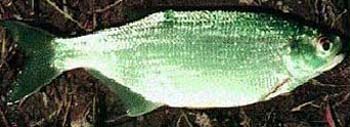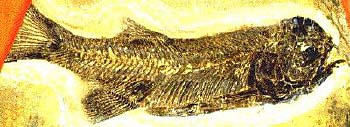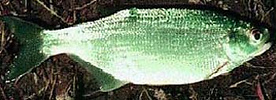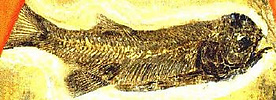Hiodon
Mooneye
Guo-Qing Li and Mark V. H. Wilson


This tree diagram shows the relationships between several groups of organisms.
The root of the current tree connects the organisms featured in this tree to their containing group and the rest of the Tree of Life. The basal branching point in the tree represents the ancestor of the other groups in the tree. This ancestor diversified over time into several descendent subgroups, which are represented as internal nodes and terminal taxa to the right.

You can click on the root to travel down the Tree of Life all the way to the root of all Life, and you can click on the names of descendent subgroups to travel up the Tree of Life all the way to individual species.
For more information on ToL tree formatting, please see Interpreting the Tree or Classification. To learn more about phylogenetic trees, please visit our Phylogenetic Biology pages.
close boxIntroduction
Hiodon is a Recent genus of fishes endemic to the inland freshwaters of North America east of the Rocky Mountains (Cavender, 1986; Li 1997; Li, Wilson, and Grande, 1997) . It is represented by two species: Hiodon tergisus Lesueur, 1818, the mooneye, and Hiodon alosoides (Rafinesque, 1819), the goldeye. Hiodon tergisus is easily distinguished from Hiodon alosoides in that its dorsal-fin origin is anterior to its anal-fin, its abdomen has a fleshy keel only between the anal- and pelvic fins, and its maxilla extends only to beneath the middle of its eye (Jordan and Evermann, 1896; Glenn, 1975).
Fossil material of Hiodon was first listed from the Miocene of North America (Smith, 1981). A recently formally named fossil species †Hiodon consteniorum from the oil shales of the Coal Creek Member of the Eocene-Oligocene Kishenehn Formation exposed along the Middle Fork of the Flathead River, northwestern Montana, suggests that the Hiodon lineage had evolved as early as the late Eocene (Li and Wilson, 1994).
Characteristics
This genus differs from all other genera in the Hiodontiformes sensu stricto in having:
- Nasal bone tubular and curved.
- Premaxillary bone with mid-dorsal concavity and no anterior process.
- Preoperclar bone with a postero-ventral rounded expansion.
- Operclar bone with an acute postero-dorsal projection and a protruding upper posterior border.
- 50-63 vertebrae.
- Neural spine on first preural centrum reduced or absent.
- Two neural spines usually developed on the second preural centrum.
Discussion of Phylogenetic Relationships
As regards the interspecific relationships among the three Hiodon species (Hiodon tergisus, Hiodon alosoides, and ![]() Hiodon consteniorum), we found only one feature at present to weekly support the sister-species relationship between Hiodon tergisus and Hiodon alosoides: present of belly keel.
Hiodon consteniorum), we found only one feature at present to weekly support the sister-species relationship between Hiodon tergisus and Hiodon alosoides: present of belly keel.
However, the recognition of the three species of Hiodon as a monophyletic group is based on the six synapomorphies as listed in the section of "Characteristics". A detailed discussion of the phylogeny of this fossil Hiodon species was given in Li and Wilson's paper of 1994.
See the leaf pages for morphological discrimination among ![]() Hiodon consteniorum, Hiodon tergisus, and Hiodon alosoides.
Hiodon consteniorum, Hiodon tergisus, and Hiodon alosoides.
Biology and Angling of Extant Hiodon
Mooneye and goldeye occur in rivers and lakes, often in waters of high turbidity (particularly for goldeye). They mainly feed on small fish, snails, insects, and crayfish. They spawn in spring (from April to June depending on the area and latitude where they live) over rocky or gravelly bottoms in slow currents. Long-distance river migration may occur. The largest specimens may be older than 13 years (e.g. some noted in Alberta, Canada, by Nelson and Paetz, 1992).
Mooneye and goldeye are popular recreational and commercial fishes in some areas, providing sport comparable to some species of trout of equivalent size (Nelson and Paetz, 1992). According to the authors' personal experience and Nelson and Paetz (1992), they take both wet and dry flies; however, they can also be caught with baits (including earthworms) and small spinning lures. Favored places for angling of mooneye and goldeye are in large turbid rivers near the mouths of small tributary streams or where a backwater meets an area of moderate current (as noted by Nelson and Paetz, 1992). They can be caught throughout the open water season, with best success in May and June.
References
Cavender, T. 1966. Systematic position of the North American Eocene fish, "Leuciscus" rosei Hussakof. Copeia, 1966: 311-320.
Cavender, T. 1986. Review of the fossil history of North American freshwater fishes. pp. 699-724 in C. H. Hocutt and E. O. Wiley (eds.), The Zoogeography of North American Freshwater Fishes. John Wiley & Sons, New York.
Glenn, C. L. 1975. Mooneye. Manitoba Nature, Summer 1975:4-7.
Gosline, W. A. 1960. Contributions toward a classification of modern isospondylous fishes. Bulletin of the British Museum (Natural History), Zoology, 6:325-365.
Grande, L. 1979. Eohiodon falcatus, a new species of hiodontid (Pisces) from the late Early Eocene Green River Formation of Wyoming. Journal of Paleontology, 53: 103-111.
Jordan, D. S., and B. W. Evermann. 1896-1900. The fishes of North and Middle America. Bulletin of the United States Natural Museum, 47:1-3313.
Lesueur, C. A. 1818. Descriptions of several new species of North American fishes. Journal of the Academy of Natural Sciences of Philadelphia, 1:359-369.
Li G.-Q. 1994. New Osteoglossomorphs (Teleostei) from the Upper Cretaceous and Lower Tertiary of North America and Their Phylogenetic Significance. Unpubl. Ph.D. dissertation, University of Alberta, Canada, 290 pp.
Li G.-Q. 1997. Notes on the historical biogeography of the Osteoglossomorpha (Teleostei). In: Proceedings of the 30th International Geological Congress. VSP International Science Publishers, Zeist, The Netherlands: 54-66.
Li G.-Q. and M. V. H. Wilson. 1994. An Eocene species of Hiodon from Montana, its phylogenetic relationships, and the evolution of the postcranial skeleton in the Hiodontidae (Teleostei). Journal of Vertebrate Paleontology, 14:153-167.
Li G.-Q. and M. V. H. Wilson. 1996. Phylogeny of Osteoglossomorpha, p. 163-174. In M. Stiassny, L. Parenti, and G. D. Johnson (eds.), Interrelationships of Fishes. Academic Press, Inc., San Diego, California.
Li G.-Q., M. V. H. Wilson and L. Grande. 1997. Review of Eohiodon (Teleostei: Osteoglossomorpha) from western North America, with a phylogenetic reassessment of Hiodontidae. Journal of PALEONTOLOGY, 71: 1109-1124.
Nelson, J. S. and M. J. Paetz. 1992. The Fishes of Alberta (2nd ed.). Unoversity of Alberta Press/University of Calgary Press, Edmonton/Calgary, 437 pp.
Smith, G. R. 1981. Late Cenozoic freshwater fishes of North America. Annual Reviews of Ecology and Systematics 12: 163-93.
Title Illustrations

Representatives of extant and fossil Hiodon.
| Scientific Name | Hiodon tergisus |
|---|---|
| Location | Central Alberta, Canada |
| Sex | Female |
| Copyright | © 1998 Wayne E. Roberts |
About This Page

Chinese Academy of Sciences, Beijing , China

University of Alberta, Edmonton, Alberta, Canada
Correspondence regarding this page should be directed to Guo-Qing Li at and Mark V. H. Wilson at
Page copyright © 1998 and
All Rights Reserved.
Citing this page:
Li, Guo-Qing and Mark V. H. Wilson. 1998. Hiodon. Mooneye. Version 01 January 1998. http://tolweb.org/Hiodon/15139/1998.01.01 in The Tree of Life Web Project, http://tolweb.org/










 Go to quick links
Go to quick search
Go to navigation for this section of the ToL site
Go to detailed links for the ToL site
Go to quick links
Go to quick search
Go to navigation for this section of the ToL site
Go to detailed links for the ToL site